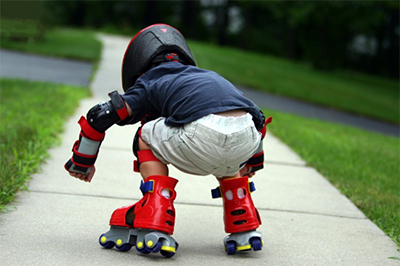March is brain injury awareness month, and children are gearing up to head back into their favorite springtime sports activities. This month is a great time for parents to take a look at the helmets their children are wearing and to become familiar with the symptoms of a concussion.
According to the Centers for Disease Control and Prevention, in “2009 an estimated 248,418 children (age 19 or younger) were treated in U.S. emergency rooms for sports- and recreation-related injuries that included a diagnosis of concussion or traumatic brain injury.” That number reflects a 57 percent increase from 2001.
There are no helmets out there that can completely prevent your child from sustaining a concussion, and the best prescription for prevention is to avoid impact to the head. A helmet can help prevent and help downgrade the severity of a sustained head injury, and CHOG recommends that all children engaging in a sports-related activity wear a helmet.
The CDC recommends that your child’s helmet should fit properly and be:
- Well-maintained
- Age-appropriate
- Worn consistently and correctly
- Appropriately certified for use
It is important to note that some sports helmets are designed for one blow only and must be replaced after an impact has occurred. The CDC recommends the following:
- Batter’s and catcher’s helmets should say NOCSAE ® 1 certified. Look at the label for date of replacement.
- Equestrian helmets should say ASTM1, SEI2, or Snell3 certified and should be replaced after one blow
- Football helmets should say NOCSAE® 1 certified and should be replaced no later than 10 years from the date of manufacture.
- Bike helmets should say U.S. Consumer Product Safety Commission (CPSC)1 certified. Replace any bicycle helmet that is damaged or has been involved in a crash.
- Skateboard helmets should be ASTM1 or Snell2 certified and are designed to withstand more than one very minor hit. However, a skateboard helmet MUST be replaced if it has been involved in a serious crash .
When to Seek Medical Treatment
The American Academy of Pediatrics recommends that a doctor should see children who experience anything more than a light bump on their head.
If a head injury is mild, parents should apply a cold compress to help with swelling and watch the child closely for 24 hours.
If your child loses consciousness, call 911. If your child has a possible neck injury do not move the child, and call 911.
The APA recommends that a physician should immediately see children with the following symptoms following a head injury:
- A constant headache, particularly one that gets worse
- Slurred speech or confusion
- Dizziness that does not go away or happens repeatedly
- Extreme irritability or other abnormal behavior
- Vomiting more than 2 or 3 times
- Stumbling or difficulty walking
- Oozing blood or watery fluid from the nose or ears
- Difficulty waking up or excessive sleepiness
- Unequal size of the pupils (the dark center part of the eyes)
- Double vision or blurry vision
- Unusual paleness that lasts for more than an hour
- Convulsions (seizures)
- Difficulty recognizing familiar people
- Weakness of arms or legs
- Persistent ringing in the ear
A doctor should see any head injury that is accompanied by cuts on the head or face or accompanies other injuries to the body. A doctor should see a child with a head injury who has nervous system problems such as seizures or a bleeding disorder.
A doctor may determine the head injury is mild and recommend home observation.
If after seeing a doctor your child experiences any of the following symptoms, a doctor should see your child again:
- Vomits more than 2 or 3 times
- Cannot stop crying
- Has a worsening headache
- Looks sicker
- Has a hard time walking, talking or seeing
- Is confused or not acting normally
- Becomes more and more drowsy or is hard to wake up
- Seems to have abnormal movements or seizures or any behaviors that worry you
Healing and Recovery
A concussion may temporarily impair your child’s ability to focus and remember. The brain however works daily to repair and heal itself. On average, it takes approximately three weeks for a child to recover completely from a concussion. Children with a history of multiple concussions may take longer to heal.
The child should refrain from any activity that could cause further injury to the head. A child should not return to sports until the child is asymptomatic at both rest and play.
Children’s Hospital of Georgia in Augusta, Ga. is the only children’s hospital in the area that delivers top-rated pediatric neurological care for children with acute and chronic neurological and developmental disorders. Visit our website at augusthealth.org/kids or call 706-721-KIDS (5437) for more information.
Sources: The American Academy of Pediatrics, AAP Gateway, Centers for Disease Control and Prevention




